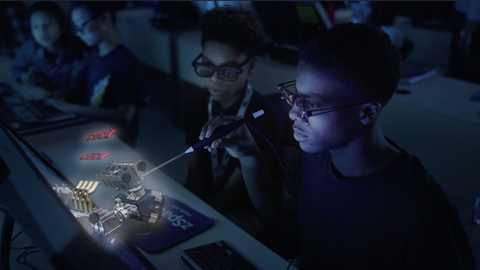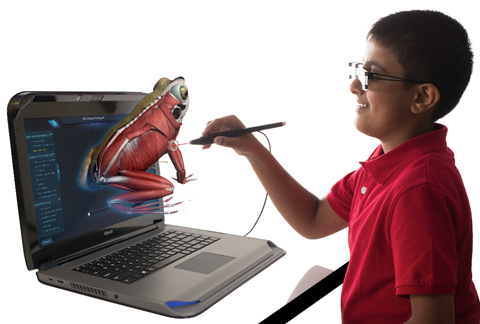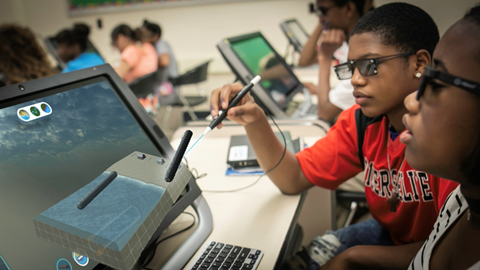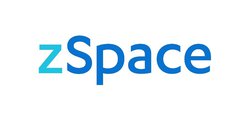zSpace breaks the screen barrier with all-in-one computers and laptops featuring 3D technology, head tracking glasses, and styli that allow students to interact with augmented and virtual reality (AR/VR) content in an immersive environment.
Applications include “zSpace Experiences” which are simulations that are experiential in nature. Students observe cause and effect, collect live data, and change conditions in the environment through lessons based on Next Generation Science Standards.
Teachers facilitate learning by setting up tools and resources that help students through each Earth, Life, and Physical Science lesson. Students learn by asking questions, gathering information, testing ideas, analyzing data, and developing conclusions. In one simulation, “Beach and River Erosion,” students explore how waves cause beach erosion, compare the use of jetties and breakwaters to control erosion, and observe erosion in a river environment and consider how it might be controlled. Student work can be assessed through saved text, photos, tables, and multiple-choice options.
Formats/platforms are used:
A fully functional Windows 10 PC, students use zSpace all-in-one (AIO) computer or zSpace AR/VR Laptop to explore the Internet, complete classwork assignments, take online assessments and industry certification exams, or any other activities for which they would use a computer at school. Once an AR/VR application is launched, students don head-tracking glasses and use the styli to interact with STEM content in a truly immersive environment. The zSpace solution tracks head movements to provide the students with a realistic learning environment and a personalized learning experience that aligns to the Next Generation Science Standards. Virtual images can be “lifted” from the screen and manipulated with the stylus. Some applications provide multi-sensory feedback; for example, students working with a virtual heart can see it pumping as well as feel it beating.

Primary website’s URL:
Problem solved:
zSpace provides districts learning experiences regardless of cost, danger, or impracticability.
Research using zSpace with middle and high school students found that the AR/VR learning environment resulted in:
• Learning gains as demonstrated by pre- and post-test scores
• Facilitating the activation of prior knowledge
• Student progression in their questioning from asking active questions based on existing knowledge to higher-level interactive questions
• Students engaging in a pedagogically appropriate learning progression
• Students constructing higher level knowledge from their virtual experiences
Simply put, zSpace makes students smarter. Learning with zSpace has shown a 16 percent average improvement in subject matter retention among all students.
Research results also indicated that zSpace facilitated the activation of students’ prior knowledge because virtual environments are active, meaning the learner must make choices or actions to advance through presented content information.
With the use of high-quality graphic images, simulated movements and auditory stimuli, zSpace enables students to fully experience science: visualize, interact with, and feel objects beyond their reach in the typical classroom.

Grade or age range:
zSpace’s student-centered activities aligning to core and CTE curricula ranges from Grade 3 through higher education.
Standards:
zSpace STEM applications, activities, and lesson plans are aligned to NGSS, Common Core, and State Standards. In addition, zSpace’s suite of self-guided CTE applications prepares students for industry certification exams and workforce opportunities.
Lesson time needed:
Lessons typically range from 10 to 60 minutes.
Pricing model:
Base pricing starts at $1299 per unit, not including software.

Additional services:
zSpace Technical Services provides best practices in planning, implementing, and managing zSpace in your school and district. The zSpace team completes system setup and configuration, while also educating the on-site technical lead what they need to know to support and manage zSpace.
To support the growing number of schools and learning centers incorporating zSpace into their curriculum, the company has also launched zSpace Community. zSpace Community serves as a forum for educators to collaborate and share resources, experiences, knowledge, and guidance on best practices for successfully incorporating zSpace AR and VR applications into lesson plans and classroom activities.
What makes zSpace unique?
Unlike other virtual reality solutions, such as head-mounted displays that can be isolating, zSpace is a Windows-based computer. While students may work independently on programs outside of zSpace’s AR/VR applications, the 3D environment and content encourage a high level of collaboration.
zSpace applications engage students in standards-based learning experiences that align with existing K12 curriculum. From calculating motion exhibited by Newton’s Cradle to modeling how humans respond to the influenza virus, students are empowered to “learn by doing” in an environment where it is easy to take risks, make mistakes, and manipulate variables.
Combining elements of AR/VR on the familiar form factor of a computer allows zSpace to inspire curiosity, create engagement, and deepen understanding for millions of learners across the world. zSpace provides more than 1,800 school districts, technical centers, medical schools, colleges, and universities access to STEM content supporting core academic and CTE curricula. Millions of students across the world today experience immersive learning applications on zSpace products as part of their lesson plans.
Characteristics:
The zSpace AIO and laptop integrates familiar interactions. For example, the stylus is held just like a pen. Students can rotate their wrist naturally as they pick up and examine virtual objects. The buttons on the stylus perform different actions depending on the application being used. Outside of zSpace-use, users can switch to using a mouse for other Windows-based applications.
How each school uses zSpace in their day-to-day teaching varies. zSpace can be configured for classrooms, labs, media centers and makerspaces - or a combination of each. Some districts use a rotational model where elementary classes will go to zSpace Experiences and do a Life Science lesson on Fish Structure and Function, then in the next period, high school classes will do a Physical Science lesson on Forces, Momentum, and Collisions. Each standards-aligned lesson plan is designed with collaboration in mind. Students work in pairs to formulate hypotheses, design experiments, manipulate variables, gather data, and draw conclusions.
Here's what users are saying:
“Bringing AR/VR to the laptop gives our students the ability to learn in a more flexible virtual environment as well as to complete traditional laptop work.”
--Sanjay Gilani, chief technology officer, Buffalo Public Schools.
"The zSpace laptop is a game-changer. We introduced the zSpace virtual reality experience at the elementary, middle and high school levels five years ago. Schools have supported their STEAM, core academic, and Career and Technical Education programs by integrating the all-in-one zSpace hardware and software solution. Now we will continue to support these programs with the new zSpace Laptop. The laptop device will give us additional flexibility as we determine our implementation models through Atlanta Public Schools."
--Aleigha Henderson-Rosser, Ed.D., Director, Instructional Technology, Atlanta Public Schools
“Our sixth graders are using zSpace to create electricity boards that we would never be able to afford or let them create for safety reasons.”
-- Joyce Thornton Barry, Plainview-Old Bethpage Central School District Chairperson of Science, Research and Technology










